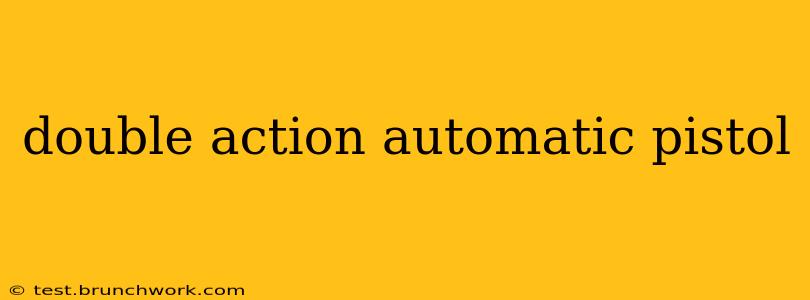Double-action automatic pistols represent a significant advancement in firearm technology, offering a blend of safety and operational efficiency. Understanding their mechanism is key to appreciating their role in both civilian and military applications. This article delves into the intricacies of these firearms, exploring their design, operation, advantages, and disadvantages.
Understanding the Double Action Mechanism
Unlike single-action pistols requiring a separate cocking of the hammer before each shot, a double-action (DA) pistol performs two actions with a single trigger pull:
- Cocking the hammer: The first part of the trigger pull cocks the hammer, readying the firing pin.
- Releasing the hammer: The continued trigger pull releases the hammer, striking the firing pin and igniting the cartridge.
This eliminates the need for manual cocking, offering a faster, more streamlined shooting process in self-defense situations. The heavier trigger pull required for the initial cocking action also acts as a safety feature.
Variations in Double Action Designs
While the core principle remains consistent, variations exist within double-action designs:
- Double-Action Only (DAO): These pistols only function in double-action mode. Each shot requires a full trigger pull. This simplifies the design and enhances safety, eliminating the possibility of accidental discharge from a cocked hammer.
- Double-Action/Single-Action (DA/SA): These pistols offer both double-action and single-action firing modes. The first shot is double-action, while subsequent shots are single-action after the hammer is cocked by the previous shot. This provides a lighter trigger pull for follow-up shots, improving accuracy and speed.
Advantages of Double-Action Automatic Pistols
The popularity of double-action pistols stems from several key advantages:
- Enhanced Safety: The heavier double-action trigger pull minimizes the risk of accidental discharge. The inherent safety of DAO pistols is particularly appealing to many users.
- Operational Simplicity: The lack of a manual cocking requirement simplifies the shooting process, making them user-friendly for individuals with varying levels of experience.
- Concealed Carry Versatility: Their compact designs and inherent safety features make them ideal for concealed carry.
- Reliability: Many double-action designs are known for their robust construction and reliable performance.
Disadvantages of Double-Action Automatic Pistols
Despite their advantages, some drawbacks exist:
- Heavier Trigger Pull: The longer, heavier trigger pull in double-action mode can affect accuracy, particularly for less experienced shooters.
- Potential for Reduced Accuracy (DAO): The heavier trigger pull of DAO pistols can make precise shot placement more challenging.
- Increased Recoil (Some Models): Depending on the design and caliber, some double-action pistols may exhibit increased recoil compared to their single-action counterparts.
Choosing the Right Double Action Pistol
Selecting the right double-action pistol depends heavily on individual needs and preferences. Consider factors like:
- Intended Use: Self-defense, target shooting, or competition will influence the choice.
- Caliber: The appropriate caliber depends on the intended purpose and personal preference.
- Size and Weight: Consider the pistol's size and weight for comfortable carrying and handling.
- Ergonomics: A comfortable grip is crucial for accuracy and control.
Conclusion
Double-action automatic pistols provide a compelling blend of safety, simplicity, and operational efficiency. Understanding the nuances of their design and operation is vital for making an informed choice. Whether you're a seasoned firearms enthusiast or a first-time buyer, careful consideration of the advantages and disadvantages will guide you towards selecting the perfect double-action pistol for your needs.
